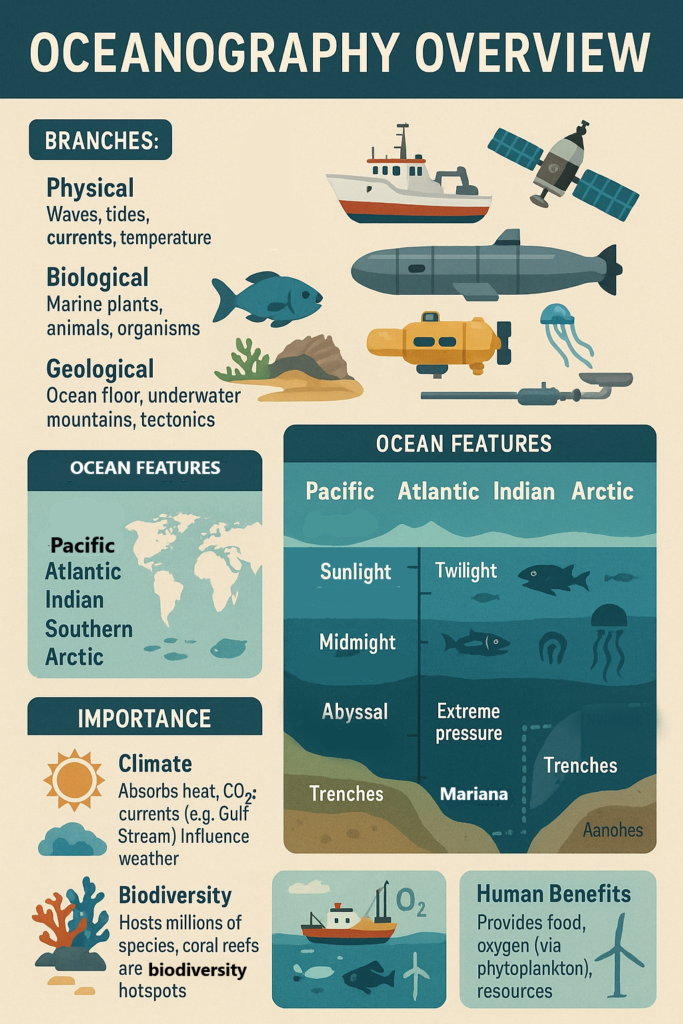Oceanography :
What is Oceanography?
Oceanography is the scientific study of the oceans. It helps us understand everything about oceans — from the waves on the surface to the creatures in the deep, and even how oceans affect the weather and climate.

Oceans cover about 71% of Earth’s surface, making them a major part of our planet. Studying them helps us learn how the Earth works, how to protect marine life, and how to prepare for natural events like tsunamis or hurricanes.
Branches of Oceanography:
- Physical Oceanography – Studies waves, tides, currents, and ocean temperature.
- Chemical Oceanography – Looks at the chemicals in ocean water (like salt, oxygen, and carbon).
- Biological Oceanography – Focuses on the plants, animals, and tiny organisms in the ocean.
- Geological Oceanography – Studies the ocean floor, underwater mountains, and tectonic activity.
Oceanographers often work with ships, submarines, satellites, and underwater robots to explore and collect data.
Features of the Ocean
Oceans are full of amazing features that affect both marine life and human life. Here are some major parts:
Major Oceans:
- Pacific Ocean (largest)
- Atlantic Ocean
- Indian Ocean
- Southern Ocean
- Arctic Ocean (smallest and coldest)
Ocean Zones (from surface to bottom):
- Sunlight Zone (Epipelagic) – Where most sea life lives.
- Twilight Zone (Mesopelagic) – Less light, fewer creatures.
- Midnight Zone (Bathypelagic) – No sunlight, very cold.
- Abyssal Zone – Near freezing, extreme pressure.
- Trenches (Hadal Zone) – Deepest parts of the ocean.
Ocean Floor Features:
- Continental Shelf – Edge of continents under shallow water.
- Mid-Ocean Ridge – Underwater mountain chains.
- Abyssal Plain – Flat, deep areas.
- Trenches – Deep cracks, like the Mariana Trench.
Importance of Oceans
1. Climate Regulation:
- Oceans absorb heat and carbon dioxide, helping to control Earth’s temperature.
- Currents like the Gulf Stream move warm and cold water around the globe, influencing weather.
2. Biodiversity:
- Oceans are home to millions of species — from tiny plankton to giant whales.
- Coral reefs are known as the “rainforests of the sea” because of their rich biodiversity.
3. Human Benefits:
- Food: Fish and other seafood are vital for billions of people.
- Oxygen: Ocean plants like phytoplankton produce over 50% of Earth’s oxygen.
- Resources: Oceans provide salt, minerals, and even medicines.
- Transport: Ships carry goods across oceans.
- Energy: Tides, waves, and offshore wind can generate renewable energy.
Threats to the Ocean and the Future
Threats:
- Pollution: Plastic, oil spills, and chemicals harm marine life.
- Climate Change: Warms ocean water, melts ice, and causes sea levels to rise.
- Overfishing: Reduces fish populations and upsets the food chain.
- Coral Bleaching: Happens when oceans get too warm, killing coral reefs.
Protecting the Ocean:
- Reduce plastic use and recycle.
- Support sustainable fishing.
- Marine protected areas help restore ecosystems.
- International cooperation is needed to protect the open seas.
The Future of Oceanography:
- New technology (like deep-sea drones) is helping us explore more.
- Oceanographers are key in fighting climate change.
- Education and awareness are crucial for ocean protection.
Summary:
Oceanography is the study of Earth’s oceans, including their physical features, chemistry, biology, and geology. Oceans play a key role in controlling the planet’s climate, supporting life, and providing resources. From deep trenches to surface waves, oceanographers explore and protect our blue planet. With increasing threats like pollution and climate change, oceanography is more important than ever to secure a healthy future for Earth and all its creatures.
Tags: abyssal plain, abyssal zone, Arctic Ocean, Atlantic Ocean, biological oceanography, chemical oceanography, climate change, climate regulation, continental shelf, coral bleaching, coral reefs, deep-sea exploration, Environmental Studies, fishing sustainability, geological oceanography, global cooperation, hadal zone, Indian Ocean, Mariana Trench, marine biodiversity, marine ecosystems, marine life, marine organisms, marine protected areas, mid-ocean ridge, midnight zone, ocean conservation, Ocean Currents, ocean floor, ocean health, ocean pollution, ocean protection, ocean research, ocean resources, ocean science, ocean temperature, ocean transportation, ocean waves, ocean zones, oceanic features, Oceanography, oceanography technology, oceans, offshore wind, overfishing, Pacific Ocean, physical oceanography, pollution reduction, Renewable Energy, Satellites, sea level rise, Southern Ocean, sunlight zone, tides, twilight zone, underwater robots, Water & Ecosystems


